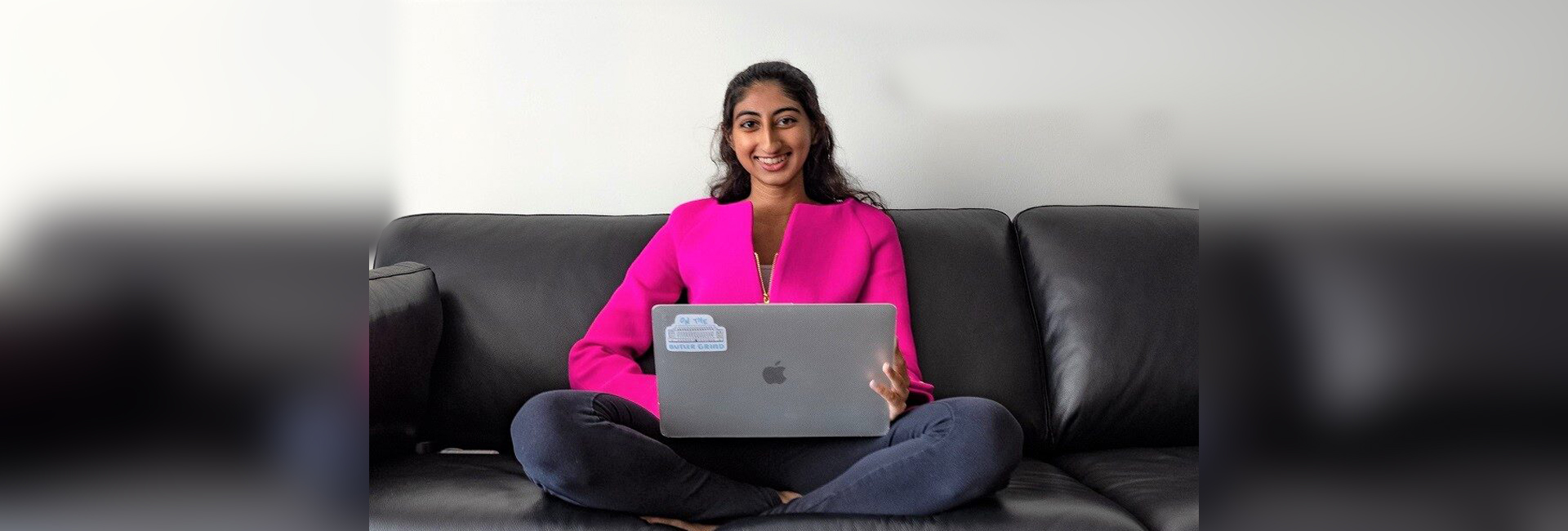(August 19, 2022) Neha Mani was a seventh grader in the Bronx, NY, when her science teacher announced the dates for an upcoming science fair. The challenge was an original life-sciences project and Neha could have stuck to the usual, middle-school fare. Instead, she followed her gut, so to speak, letting her interest in microbiology lead the way. It was a good call. She went on to design, a couple of years later, a diagnostic tool for Inflammatory Bowel Disease (IBD), which fetched her the H. Robert Horvitz Prize for Fundamental Research at the Regeneron ISEF, the largest high school science fair in the US. Global Indian takes a look at her story.
Now a student at Columbia University, Neha has applied for a US patent. Her diagnostic tool, which uses Machine Learning, is based on the concept of bacterial swarming and has the potential to also difficult-to-diagnose intestinal disorders like Crohn’s disease and ulcerative colitis. “Prior evidence has linked bacterial swarming to IBD and bacterial swimming to a healthy gut,” she explains.

Neha M. Mani
A gut feeling
Even in seventh grade, Neha was not content with “growing Brassica rapa in a number of nutrient-deficient, light-starved conditions, would not illuminate its secret environmental resilience,” she says. Besides, had tried that already, in sixth grade. Instead, she found herself captivated by a subject seemed, at the time, to be “teeming with mystery”: Microbiology. She was intrigued by bacteria, by the idea that something that isn’t visible to the human eye could have such an effect on the human body.
As she explored the subject, she was amazed to find recent studies indicating just how sophisticated these microorganisms truly are – “they can communicate in chemical pathways between and within species, acting as a previous parallel to the nuances of human language,” she writes, in the Mazziotti Group journal. This phenomenon, ‘chemical communication’ is used by several species and involves a reliance on pheromones. In bacteria, the process is called ‘quorum sensing’ and allows bacteria to monitor their environment for the presence of other bacteria and alter their behaviour in response to fluctuations in number.
However, the study of how bacteria coordinate movements required access to sophisticated imaging technology, which Neha just didn’t have. So, she used a petri dish and quantified the extent of bacterial movement from the edge of the colony to the centre of the dish. Even as she began, however, she wanted to understand what implications her research would have on human life.
Make science human again
“I think beyond scientific discovery and dreams of innovation, I want to be renowned for humanising my science,” she said, in an interview. “I believe any field combining medicine and research requires empathy for the problem at hand. Some say emotion is the enemy of rational thought, in science research, I find that it is perhaps the greatest motivator.”
The seventh-grade science fair was no longer an important milestone. Neha dedicated herself to a year of research, combing through reviews and articles on bacterial behaviour. When she was a freshman in high school, another opportunity came around, this time demanding “investigation of a higher caliber than our previous project.”
She had found that bacterial movement was also their means of communication with the human body and she had identified two distinct kinds of movement. Bacterial swarming, which she describes as a “dynamic, collective motion,” is associated with inflammation, while swimming (individualised, chaotic motion) is linked to a healthy gut.
By this time, she needed more than what her high school laboratory could offer her. She needed access to better equipment and also, a mentor, to offer guidance as she proceeded. Both were difficult to find – her endeavour was idealistic and ambitious, perhaps too much so. The work involved the intersection of numerous disciplines, from engineering to computer science, physics and microbiology.
Neha began sending her proposal around to various labs around New York City and was met with a stream of rejection. In the end, the green light came from Brown University, which agreed to let her carry out her research under the guidance of a PhD student at the time, Weijie Chen.
An affordable, accurate tool to diagnose IBD
Slowly, as she reworked her experimental design, observing the mechanics of bacterial motion and using Particle Image Velocimetry to optimise accuracy and visibility, she saw her work begin to take shape. It also meant she had to learn new concepts in calculus and physics, a challenge she happily accepted. Finally, she had what she was looking for: a tool to detect Inflammatory Bowel Disease.
IBD is fairly common but also difficult to diagnose – it shows up differently in different people. Crohn’s disease, for instance, a type of IBD, can affect different parts of the intestinal tract. The symptoms could also indicate a number of other conditions, which need to be ruled out. It also cannot be detected using blood tests. Diagnosis usually involves a colonoscopy, enterography, endoscopy or an upper GI series (barium swallow). The process invasive, tedious and also expensive.
In India, an estimated 1.5 million people suffer from Inflammatory Bowel Disease – it is second only to the USA, according to a study by Wellness 365. This is where Neha hopes her tool will make a difference – if it is developed further, she said in her video for ISEF, it can be “efficient, economical, safe, accurate and specific to IBD.”
When she’s not in a lab, Neha, who is now majoring in biochemistry and linguistics, enjoys scuba diving and underwater photography. In an interview with Society for Science, she said, “I wish we could have dynamic oxygen tanks that extract dissolved oxygen from the oceans and compounded it with nitrogen so we could breathe underwater for as long as we want.” She is a certified, Master Scuba Diver and is also involved with coral registration efforts.

